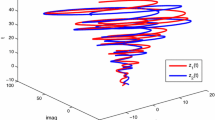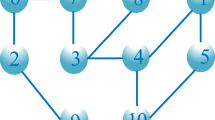Abstract
This paper focuses on the multisynchronization problem of delayed fractional-order neural networks with parametric uncertainties. Firstly, partition space method is used to determine that each subnetwork of fractional-order neural networks has \(\prod \nolimits _{j=1}^n{\left( K_j+1 \right) }\) locally Mittag-Leffler stable periodic orbits or equilibrium points. Secondly, a universal impulsive controller is proposed to impose on each node except the last one, and all nodes eventually tend to the same state. By means of average impulsive interval method, linear matrix inequality (LMI) and some other inequality techniques, the sufficient conditions for the dynamical and static multisynchronization of whole systems are respectively given. Finally, two numerical examples are provided to illustrate the correctness of the theoretical results.










Similar content being viewed by others
References
Wu GC, Deng ZG, Baleanu D et al (2019) New variable-order fractional chaotic systems for fast image encryption. Chaos: Interdiscipl J Non Linear Sci 29(8):083103
Cohen MA, Grossberg S (1983) Absolute stability of global pattern formation and parallel memory storage by competitive neural networks. IEEE Trans Syst Man Cybern 13(5):815–826
Momani S, Odibat Z (2006) Analytical approach to linear fractional partial differential equations arising in fluid mechanics. Phys Lett A 355(4–5):271–279
Kalogirou SA (2000) Applications of artificial neural-networks for energy systems. Appl Energy 67(1–2):17–35
Xu SC, Wang XY, Ye XL (2022) A new fractional-order chaos system of Hopfield neural network and its application in image encryption. Chaos Solitons Fract 157:111889
Lee SH, Park MJ, Ji DH et al (2022) Stability and dissipativity criteria for neural networks with time-varying delays via an augmented zero equality approach. Neural Netw 146:141–150
Hu C, Jiang HJ, Teng ZD (2010) Globally exponential stability for delayed neural networks under impulsive control. Neural Process Lett 31:105–127
Sun PF, Zhao XD, Sun T et al (2020) Global stability at a limit cycle for switched multi-valued logical networks. Asian J Control 25:860–870
Wan L, Wu A (2018) Multistability in Mittag-Leffler sense of fractional-order neural networks with piecewise constant arguments. Neurocomputing 286:1–10
Wan LG, Wu AL (2018) Multistability in Mittag-Leffler sense of fractional-order neural networks with piecewise constant arguments. Neurocomputing 286(19):1–10
Liu P, Zeng ZG, Wang J (2017) Multiple Mittag-Leffler stability of fractional-order recurrent neural networks. IEEE Trans Syst Man Cybern Syst 47(8):2279–2288
Liu P, Zeng ZG, Wang J (2020) Asymptotic and finite-time cluster synchronization of coupled fractional-order neural networks with time delay. IEEE Trans Neural Netw Learn Syst 31(11):4956–4967
Yang QJ, Wu HQ, Cao JD (2021) Pinning exponential cluster synchronization for fractional-order complex dynamical networks with switching topology and mode-dependent impulses. Neurocomputing 428:182–194
Meng X, Jiang BP, Gao CC (2022) Sliding mode projective synchronization for fractional-order coupled systems based on network without strong connectedness. Trans Inst Meas Control 44(4):775–783
**ao YZ, Xu W, Li XC et al (2008) Complete synchronization of uncertain chaotic dynamical network via a simple adaptive control. Chin Phys B 17(1):80–86
Aravinth N, Sakthivel R, Aouiti C et al (2021) Finite-time synchronization of hierarchical hybrid coupled neural networks with mismatched quantization. Neural Comput Appl 33:16881–16897
Shao S, Liu X, Cao JD (2021) Prespecified-time synchronization of switched coupled neural networks via smooth controllers. Neural Netw 133:32–39
**u RH, Zhang W, Zhou ZC (2022) Synchronization issue of coupled neural networks based on flexible impulse control. Neural Netw 149:57–65
Wang YW, Yang W, **ao JW et al (2016) Impulsive multisynchronization of coupled multistable neural networks with time-varying delay. IEEE Trans Neural Netw Learn Syst 28(7):1560–1571
Lv XX, Li XD, Cao JD et al (2018) Dynamical and static multisynchronization of coupled multistable neural networks via impulsive control. IEEE Trans Neural Netw Learn Syst 29(12):6062–6072
Lu JQ, Cao JD (2011) Exponential synchronization of linearly coupled neural networks with impulsive disturbances. IEEE Trans Neural Netw 22(2):329–336
Fang J, Zhang Y, Liu P et al (2021) Fixed-time output synchronization of coupled neural networks with output coupling and impulsive effects. Neural Comput Appl 33:17647–17658
Yang X, Li C, Huang T et al (2017) Global Mittag-Leffler synchronization of fractional-order neural networks via impulsive control. Neural Process Lett 48(1):459–479
Pan LJ, Cao JD, Al-Juboori UA et al (2019) Cluster synchronization of stochastic neural networks with delay via pinning impulsive control. Neurocomputing 366:109–117
Zhang JE (2017) Multisynchronization for coupled multistable fractional-order neural networks via impulsive control. Complexity 2017:1–10
Hua C, Ge C, Guan X (2015) Synchronization of chaotic Lure systems with time delays using sampled-data control. IEEE Trans Neural Netw Learn Syst 26(6):1214–1221
Lv H, He WL, Han QL et al (2019) Fixed-time pinning-controlled synchronization for coupled delayed neural networks with discontinuous activations. Neural Netw 116:139–149
Wang J, Liang J, Zhang CT et al (2021) Event-triggered non-fragile control for uncertain positive roesser model with PDT switching mechanism. Appl Math Comput 406:126266
Lgor F, Artem N, Pavel G (2022) Synchronization of multi-machine power systems under disturbances and measurement errors. Int J Adapt Control Signal Process 36(6):1272–1284
Lin HR, Wang CH, Chen CJ et al (2021) Neural bursting and synchronization emulated by neural networks and circuits. IEEE Trans Circuits Syst I Regul Pap 68(8):3397–3410
Berry C, Komninos N (2022) Efficient optimisation framework for convolutional neural networks with secure multiparty computation. Comput Secur 117:102679
Gao XY, Zhang P, Huang GH et al (2022) Financial information prediction and information sharing supervision based on trend assessment and neural network. Soft Comput 24(11):8087–8096
Liu P, Zeng ZG, Wang J (2017) Multistability of recurrent neural networks with nonmonotonic activation functions and unbounded time-varying delays. IEEE Trans Neural Netw Learn Syst 29(7):3000–3010
Tan M, Liu YF, Xu DS (2019) Multistability analysis of delayed quaternion-valued neural networks with nonmonotonic piecewise nonlinear activation functions. Appl Math Comput 341:229–255
Hu B, Guan ZH, Chen GR et al (2019) Multistability of delayed hybrid impulsive neural networks with application to associative memories. IEEE Trans Neural Netw Learn Syst 30(5):1537–1551
Zhang FH, Zeng ZG (2021) Multistability of fractional-order neural networks with unbounded time-varying delays. IEEE Trans Neural Netw Learn Syst 32(1):177–187
Acknowledgements
This work was jointly supported in part by NSF of China (Nos. 11861060 and 11771259), NSF of Shaanxi University of Science and Technology (No. 2021BJ-17), Shaanxi Provincial Joint Laboratory of Artificial Intelligence (No. 2022JC-SYS-05), National program for the introduction of high-end foreign experts (No. G2023041032L), Innovative team project of Shaanxi Provincial Department of Education (No. 21JP013) and Shaanxi Province Natural Science basic research program key project (No. 2023-JC-ZD-02).
Author information
Authors and Affiliations
Corresponding author
Ethics declarations
Conflict of interest
The authors declare that there is no conflict of interest in this paper.
Additional information
Publisher's Note
Springer Nature remains neutral with regard to jurisdictional claims in published maps and institutional affiliations.
Rights and permissions
Springer Nature or its licensor (e.g. a society or other partner) holds exclusive rights to this article under a publishing agreement with the author(s) or other rightsholder(s); author self-archiving of the accepted manuscript version of this article is solely governed by the terms of such publishing agreement and applicable law.
About this article
Cite this article
Wang, X., Ding, X., Li, J. et al. Multisynchronization of Delayed Fractional-Order Neural Networks via Average Impulsive Interval. Neural Process Lett 55, 12437–12457 (2023). https://doi.org/10.1007/s11063-023-11427-6
Accepted:
Published:
Issue Date:
DOI: https://doi.org/10.1007/s11063-023-11427-6




